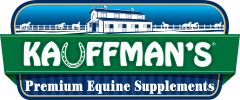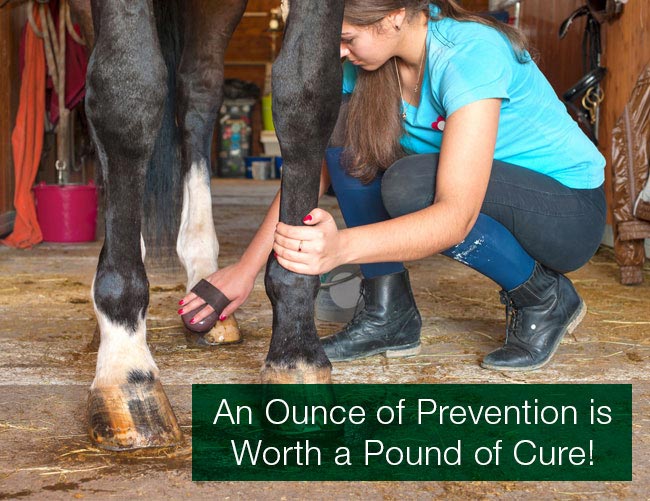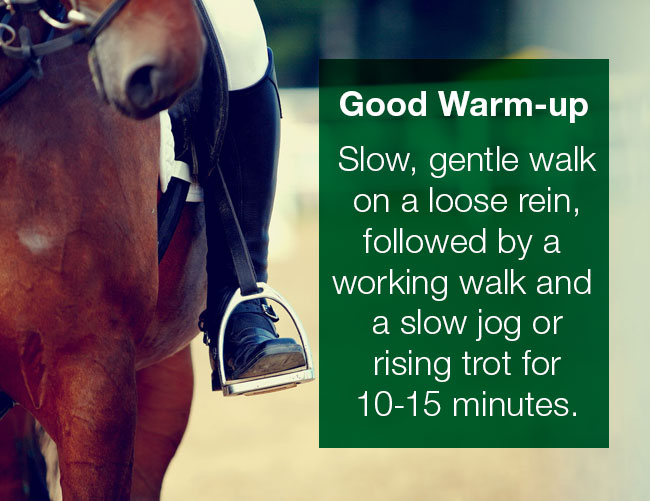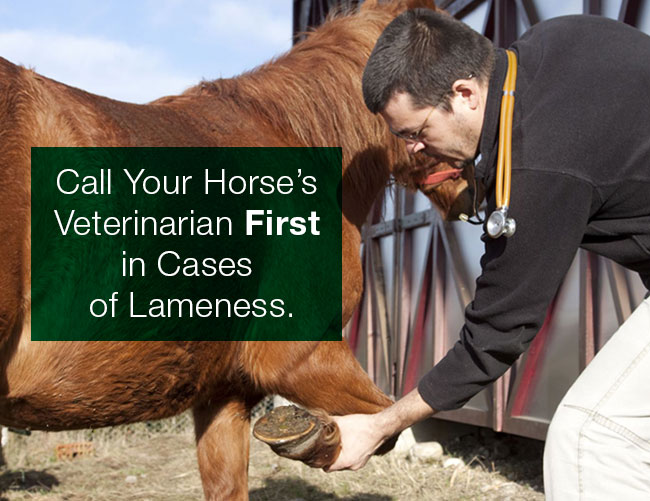10 Tips on How to Prevent Lameness in Horses

Preventing lameness in horses is important, whether you ride competitively or for pleasure. An unsound horse should not be ridden, resulting in many weeks of lost training for horse and rider. Unsoundness also disrupts show schedules and can derail competitive plans for an entire year if a horse misses certain competitions.
Fortunately, there are many steps you can take to keep your horse sound. From selecting a horse whose conformation is suited to your chosen discipline to practicing good overall horse care, you can keep your horse fit and sound for many years to come.
Disadvantages of Lameness
When a horse goes lame, you can’t ride them. Riding a lame horse can injure it further and will almost certainly cause pain. You certainly don’t want to hurt your horse!
If you’re riding and you feel the telltale hitch or skip in your horse’s stride that indicates lameness, bring your horse back to a walk, then halt and dismount. Walk your horse back to the barn where you can evaluate her to pinpoint the source of lameness. It may be as simple as a thrown shoe or as complex as a sore back.
Lameness can be a real disruption in your training schedule. Not only do you lose days to lameness, but your horse may also lose muscle tone if it’s on stall rest for a while.
A lame horse can also derail any hopes you have of winning coveted breed titles, championships or spots at major horse shows if you’re chasing points. If you need to accumulate a certain number of points at local shows or rated shows, and you have to miss some due to lameness, you may not qualify for championship shows and awards. For the competitive horse and rider team, this can be an upsetting setback.
There’s no fun in having a horse if you can’t ride. Making sure your horse is sound and healthy keeps you both enjoying time together in the ring or on the trail.
10 Tips on How to Prevent Lameness in Horses
To keep you and your horse in the running for the ribbons, use these tips to prevent lameness in horses:
- Choose the right horse for the right sport: Each horse’s conformation differs depending on the breed and the individual equine. When you’re shopping for a horse, choose one with the conformation and breed characteristics suited to the discipline you wish to ride in. Competition horses must have strong, sturdy legs and feet as well as overall good health to remain sound. Trying to compete with a horse unsuited to the discipline you’re showing in isn’t fair to either you or the horse and may contribute towards lameness. Choose the right horse for the job.
- Provide proper daily hoof care: Caring for your horse’s hooves is essential to preventing lameness. Horses should have their hooves picked out daily. Using a hoof pick, clean manure and mud from the frog and hoof interior. Check your horse’s shoes daily, and note any unusual changes, odors or discharge from the hoof during daily care. Call your veterinarian or farrier promptly at the first sign of infection, deep cracks or other problems. An ounce of prevention is worth a pound of cure when it comes to a horse’s hoof care.
- Schedule regular farrier visits: In addition to daily hoof care, regular trims are essential to good hoof health. New shoes are needed every six to eight weeks on average if you keep your horse shod. Even those who prefer to keep a horse barefoot should schedule professional trims to ensure the proper hoof angle. An incorrect hoof angle can cause excessive strain on the horse’s muscles, tendons and ligaments.
- Check stall floors: Horses should not be stabled on concrete or other unyielding surfaces. Although some barns do have concrete flooring, rubber stall mats added over concrete floors can provide a softer cushion and prevent soreness and lameness. A good, deep bed of straw or wood shavings on top of hard-packed dirt is one of the best floors for preventing lameness in horses.
- Improve arena footing: Arena footing should also cushion your horse’s footfalls, especially if he’s training in high-impact disciplines such as hunters, jumpers or reining. There are many types of footing available for arenas including sand, artificial footing and dirt. The important thing to keep in mind is that the footing should be even and have some “give” in it to offer your horse some cushioning. Never ride a horse over concrete for long periods of time, as the excessive pounding can cause lameness.
- Check saddle fit: Learning how to keep your horse sound also includes making sure his tack fits properly. Improperly fitted saddles can cause pressure sores and back strain, which can make a horse lame. You may need your trainer to help you assess saddle fit. Foam, rubber or fleece pads can be added under saddles to adjust the fit, or you may need to try another type of saddle to ensure proper fit.
- Warm up properly: Correctly warming up and cooling down a horse is also essential to preventing lameness. The warm-up helps the horse’s blood start flowing to his muscles and eases him into work. This is especially important if he’s kept in a stall most of the time. A slow, gentle walk on a loose rein, followed by a working walk and a slow jog or rising trot for about 10-15 minutes in both directions in the arena, is a good warm-up. Only after warming up your horse properly should you commence with a lesson or training exercises.
- Cool down properly, too: Learning how to keep your horse sound also includes cooling down horses after workouts. Just like a proper warm-up, cooling down transitions a horse from a workout to stall rest or turnout. Slow down your training session and end with at least ten minutes of a nice, easy walk on a loose rein to cool your horse down properly.
- Leg protection: Leg protection keeps horses from hitting their legs against other surfaces, such as jumps or trailer entrances, and also protects legs during training. When you’re trailering your horse, always wrap front and back legs in shipping boots or wraps. The best shipping boots extend over the coronet band and cover the top of the hoof, providing additional protection for the hoof as well as the ankle and leg. During training, your horse may need polo wraps, front boots, back boots, bell boots or any number of leg protection accessories. Your trainer can advise you on the best leg protection for your sport, make sure you are wrapping your horses legs the proper way! Some horses even benefit from leg protection during turnout, especially if they tend to be the rambunctious sort!
- Safe turnout: Watch out for wet, muddy days, which make the ground slippery. Horses can slip just like people can, and when they do, they can become lame from pulling muscles or ligaments. Group turnout increases the chances of lameness simply because the more horses in a herd, the greater the chance they’ll get into mischief. A mistimed kick at a fly can end up injuring an otherwise sound horse standing too close. If you’re a serious competitor, consider turning your horse out individually to avoid turnout injuries.
Assessing Lameness
Even if you’ve done everything you can to keep your horse sound, one day you may head out on the trail or start your warm-up and feel that telltale hitch in his gait. Walk your horse to the center of the arena and dismount, or if you’re on a trail, walk back to the barn.
You may need a helper to hold your horse and jog him out for you to assess the source of lameness. Follow these steps to pinpoint where your horse is hurting:
- Stand your horse as square as you can on a solid, even surface. Walk around your horse. Note if she’s holding one hip higher than the other or keeping weight off of a leg. Examine each hoof and leg. Start with the near front and work your way to the near hind, off front and off hind or whatever pattern your horse is used to for daily hoof care. Check to make sure there’s no foreign object lodged in the shoe or frog and that the shoes are on securely.
- Examine each hoof and leg. Start with the near front and work your way to the near hind, off front and off hind or whatever pattern your horse is used to for daily hoof care. Check to make sure there’s no foreign object lodged in the shoe or frog and that the shoes are on securely.
- Feel each hoof and leg up to the elbow for heat, blemishes, cuts or swelling.
- Have your helper walk your horse in a circle around you, then jog your horse out. A bobbing or nodding head is a sure sign of lameness. A horse nods his head in time to his lameness, with the head jerking up when the lame leg hits the ground. Repeat this exercise in both directions.
- Listen to the horse’s hoof beats. When the pattern is off, note which foot is striking the ground. That may be the lame one. Subtle lameness may only manifest during riding sessions. If your horse feels “off” without obvious signs of lameness, such as limping or head-nodding, you may need to ride your horse during a veterinarian examination to have a professional assess the source of lameness.
- Subtle lameness may only manifest during riding sessions. If your horse feels “off” without obvious signs of lameness, such as limping or head-nodding, you may need to ride your horse during a veterinarian examination to have a professional assess the source of lameness.
Serious Causes of Lameness
There are several serious causes of lameness or unsoundness that require an emergency call to your horse’s veterinarian. A fracture or break is one such case, as is a deep puncture wound to the hoof. Deep cuts or gashes on the leg need emergency treatment and examination by your horse’s veterinarian.
Tying up, or azoturia, is a serious disease caused by the buildup of lactic acid in a horse’s muscles. Some horses are more prone to azoturia than others, but the disease can also be caused by strenuous workouts with an improper warm-up or strenuous workouts for which the horse isn’t properly conditioned. Horses suddenly stiffen up and go lame during your riding session or immediately after. Cover your horse with a cooler, lightweight stable sheet or blanket and call the veterinarian immediately.
Other diseases that can cause lameness in horses include:
- Laminitis: Laminitis, also called founder, causes severe lameness in horses. It can be caused by infection or improper feeding, especially feeding too-rich pasture grass or feed mixtures to horses who aren’t used to it. Call your horse’s veterinarian if you suspect laminitis. If left untreated or improperly treated, your horse can be permanently lame after foundering.
- Navicular disease: Navicular disease is a set of changes or damage to the navicular bone in the hoof. It can cause lameness of varying degrees. Some navicular changes can be counteracted with proper shoeing. Supplements can be helpful in addition to proper trimming and shoeing.
Call the Vet or the Farrier?
Unless the cause of lameness is easy to spot, such as a thrown shoe, call your horse’s veterinarian first in cases of lameness. Lameness can be caused by so many factors that only a veterinarian is skilled enough to rule out each potential cause and pinpoint the right treatment for your horse.
Farriers are experts in hoof care. If your horse frequently goes lame, talk to her farrier about supplements, shoes or pads that may help. Your farrier may suggest special shoes to protect the sole, bars and frog.
A Healthy Horse Is a Sound Horse
Just as certain supplements can help people with bone, joint, skin and nail problems, supplements can help your horse, too. Preventing lameness in horses includes proper horse care, riding skills, stable management and feeding.
When selecting supplements, consult with your horse’s veterinarian about which ones might be helpful. For example, some supplements strengthen hooves. If your horse loses shoes easily or tends to have cracked hooves, adding a supplement as well as applying hoof dressing and conditioner may help.
Kauffman’s® equine supplements have helped to keep horses sound and healthy for over 35 years. Kauffman’s® Animal Health products for horses include:
- Biotin, for strong hooves
- Brewer’s Yeast, for a healthy coat
- Integri-Hoof, which features a complete and balanced supplement mix for strong, healthy hooves
- Flex Steps containing Chondroitin, for joint issues
- And much more
Our quality supplements are manufactured in our American facility, and have been trusted by horse owners for more than three decades. You can select a specific supplement or a blend that includes the proper ratio of ingredients to support equine health for a specific condition or concern.
Sign up now for our email list, which includes special deals and equine care tips.
When it comes to equine nutrition, only the best will do for your performance horse. Choose Kauffman’s® products, the name horse owners have known and trusted for over 35 years.




